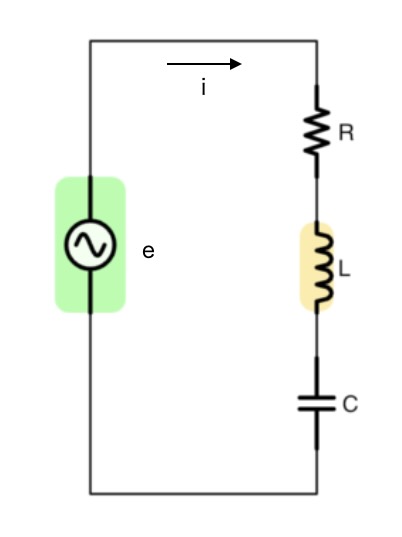I wrote about the idea of representing AC circuits using complex numbers.
Consider an RLC series circuit as shown in Figure 1.

Now, the instantaneous value of the current flowing through this circuit is
$$i(t)=I_m\sin(\omega t-\theta)\hspace{185pt}(1)$$
The instantaneous value of voltage is
$$e(t)=Ri(t)+L\frac{di(t)}{dt}+\frac{1}{C}\int i(t)dt\hspace{130pt}(2)$$
$$=RI_m\sin(\omega t-\theta)+L\frac{d}{dt}\{I_m\sin(\omega t-\theta)\}+\frac{1}{C}\int I_m\sin(\omega t-\theta)dt\hspace{15pt}(3)$$
Here, there are two options: to calculate as is, or to calculate using complex numbers, but here we will consider a method using complex numbers.
Use Euler’s formula to calculate with complex numbers.
$$e^{j\theta}=\cos\theta+j\sin\theta\hspace{40pt}(j=\sqrt{-1})\hspace{110pt}(4)$$
If we replace θ part with ωt-θ,
$$e^{j(\omega t-\theta)}=\cos(\omega t-\theta)+j\sin(\omega t-\theta)\hspace{120pt}(5)$$
If we focus on the imaginary part of equation (5), we can see that it is the same as the sin(ωt-θ) part of equation (3).
Don’t you think the calculation would be easier if we converted the sin(ωt-θ) part of equation (3) into an exponential function using Euler’s formula?
This is because the shape of the exponential function e does not change whether it is differentiated or integrated.
However, Euler’s formula uses only the sin term in the imaginary part, not the cos term in the real part. Although there is only a sin term in equation (2), we assume that there is a cos term and convert it using Euler’s formula. After completing the calculation, write only the sin term of the imaginary part.
When formula (2) is converted to exponential notation using Euler’s formula, we get
$$e(t)=RI_me^{j(\omega t-\theta)}+L\frac{d}{dt}I_me^{j(\omega t-\theta)}+\frac{1}{C}\int I_me^{j(\omega t-\theta)}dt\hspace{140pt}$$
$$=RI_me^{j(\omega t-\theta)}+j\omega LI_me^{j(\omega t-\theta)}+\frac{1}{j\omega C}I_me^{j(\omega t-\theta)}\hspace{140pt}$$
$$=RI_me^{j(\omega t-\theta)}+j\omega LI_me^{j(\omega t-\theta)}+\frac{1}{j\omega C}\cdot\frac{j}{j} I_me^{j(\omega t-\theta)}\hspace{140pt}$$
$$=RI_me^{j(\omega t-\theta)}+j\omega LI_me^{j(\omega t-\theta)}-\frac{j}{\omega C}I_me^{j(\omega t-\theta)}\hspace{140pt}$$
$$=\{R+j(\omega L-\frac{1}{\omega C})\}I_me^{j(\omega t-\theta)}\hspace{140pt}(6)$$
$$\\\\$$

Now, considering the complex number Z in equation (6)
$$Z=R+j(\omega L-\frac{1}{\omega C})$$
Then
$$Z=|Z|\{\frac{R}{|Z|}+\frac{1}{|Z|}j(\omega L-\frac{1}{\omega C})\}$$
$$=\sqrt{R^2+(\omega L-\frac{1}{\omega C})^2}\{\frac{R}{\sqrt{R^2+(\omega L-\frac{1}{\omega C})^2}}+\frac{1}{\sqrt{R^2+(\omega L-\frac{1}{\omega C})^2}}j(\omega L-\frac{1}{\omega C})\}$$
There is the following relationship on the complex plane
$$\frac{R}{|Z|}=\cos\varphi$$
$$\frac{\omega L-\frac{1}{\omega C}}{|Z|}=\sin\varphi$$
$$\varphi=\tan^{-1}\frac{\omega L-\frac{1}{\omega C}}{R}$$
therefore
$$Z=|Z|(\cos\varphi+j\sin\varphi)$$
$$=|Z|e^{j\varphi}$$
Therefore, equation (6) is
$$e(t)=|Z|e^{j\varphi}I_me^{j(\omega t-\theta)}$$
$$=\sqrt{R^2+(\omega L-\frac{1}{\omega C})^2}I_me^{j(\omega t-\theta+\varphi)}$$
$$=\sqrt{R^2+(\omega L-\frac{1}{\omega C})^2}I_m\{\cos(\omega t-\theta+\varphi)+j\sin(\omega t-\theta+\varphi)\}$$
Here, if we take only the sin term of the imaginary part, we get
$$e(t)=\sqrt{R^2+(\omega L-\frac{1}{\omega C})^2}I_m\sin(\omega t-\theta+\varphi)$$
In this way, circuit calculations can be performed using Euler’s formula.
The key points here are as follows. Now, using Euler’s formula, we can express the instantaneous value of the current flowing in the circuit as follows.
$$i(t)=I_m\sin(\omega t-\theta)=I_m e^{j(\omega t-\theta)}$$
The instantaneous value of the power supply voltage is as shown below
$$e(t)=RI_me^{j(\omega t-\theta)}+j\omega LI_me^{j(\omega t-\theta)}+\frac{1}{j\omega C}I_me^{j(\omega t-\theta)}\hspace{140pt}$$
For simplicity, if we set i(t)=I and e(t)=E, then
$$E=RI+j\omega LI+\frac{I}{j\omega C}$$
In this formula, the key point is that multiplying by jω is the same as differentiating the instantaneous value of the current, and multiplying by 1/jω is the same as integrating the instantaneous value of the current.
Since the shape of the exponential function e does not change due to calculus, all you need to do is perform the calculation in complex number notation in this way, and when the calculation is finished, return I to the initial instantaneous value notation of the current.
If a rather complex equation involving the calculus of trigonometric functions is converted into complex number notation using Euler’s formula, all you need to do is calculate a simple algebraic equation!
